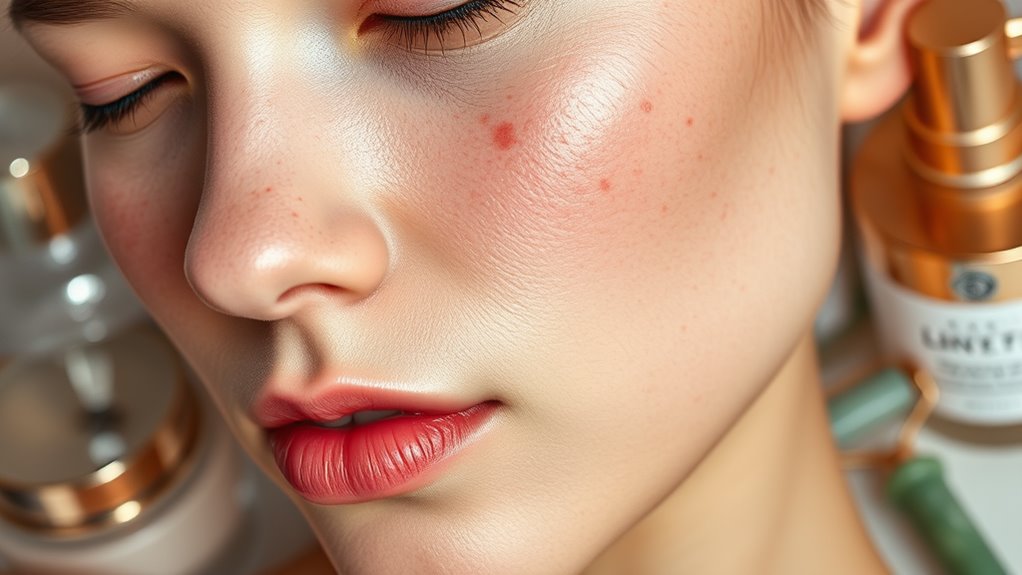Think You Have Sensitive Skin. These Signs Say Otherwise
You may think you have sensitive skin, but true sensitivity shows specific signs. Look out for persistent redness, itching, or burning sensations that don’t go away. Environmental stressors, certain ingredients, and overusing products can trigger irritation, mislabeling your skin as sensitive. Allergies, eczema, or rosacea might be causing similar symptoms. Identifying your skin’s true condition is essential for proper care. Want to understand more about what might actually be affecting your skin?
Key Takeaways
- Persistent redness that does not subside may indicate irritation rather than sensitive skin, which typically has intermittent reactions.
- Frequent stinging or burning sensations can result from product misuse rather than skin sensitivity.
- Dry patches that flake or peel might signal dehydration, not necessarily sensitivity, especially if they respond well to moisturization.
- Increased reactivity to temperature changes can be a sign of skin irritation caused by environmental factors, not true sensitivity.
- True sensitive skin often involves a compromised barrier, while irritation may stem from allergens or harsh products instead.
Understanding Sensitive Skin
Sensitive skin is a condition characterized by heightened reactivity to various stimuli, including environmental factors and skincare products.
You may notice sensitive skin symptoms such as redness, itching, burning, or stinging, often triggered by changes in temperature, exposure to UV light, or certain chemicals in cosmetics.
These reactions occur due to an impaired skin barrier, which fails to protect against irritants effectively.
You might also experience dryness or flakiness, indicating a lack of moisture retention.
Identifying these symptoms allows you to tailor your skincare regimen, opting for hypoallergenic products and avoiding known irritants.
Understanding your skin’s responses is crucial for managing sensitivity and preventing exacerbation of symptoms, ultimately leading to healthier skin management strategies. Additionally, it is important to recognize that an impaired skin barrier can contribute significantly to the sensitivity experienced.
Common Misconceptions About Sensitive Skin
Many people misunderstand what causes sensitive skin, attributing reactions to specific products without considering individual skin types. It’s essential to recognize that sensitivity can stem from various factors, including environmental influences and underlying skin conditions. Understanding true sensitivity symptoms can help individuals identify their specific skin needs more accurately.
True Causes of Sensitivity
Although it’s easy to assume that sensitivity stems solely from skin type, various factors contribute to this condition. Environmental factors, underlying health issues, and skincare products can all play significant roles.
| Factor | Description | Impact on Sensitivity |
|---|---|---|
| Environmental Stressors | Pollution, UV exposure, and climate conditions | Can weaken skin barrier |
| Allergens | Ingredients in products or natural allergens | Trigger inflammatory responses |
| Hormonal Changes | Fluctuations due to menstrual cycles or stress | Alter skin’s reaction to stimuli |
| Health Conditions | Conditions like eczema or rosacea | Increase skin reactivity |
Understanding these true causes allows you to address sensitivity more effectively, leading to better management strategies tailored to your specific needs.
Misunderstanding Skin Reactions
When it comes to skin reactions, misconceptions often cloud understanding and lead to ineffective treatment. Many people mistakenly equate irritation with sensitive skin, neglecting to consider underlying factors.
Here are common misconceptions that can hinder your approach:
-
Sensitive skin is always reactive: Not all reactions indicate sensitivity; some may stem from allergies or irritants.
-
Only certain products cause reactions: Environmental factors, such as pollution, can also trigger skin issues.
-
All skin types can’t handle the same products: Individual tolerance varies widely, regardless of skin type.
-
Avoiding all products is the solution: Over-restriction can worsen sensitivity; a targeted approach is essential.
Clarifying these misconceptions helps you develop a more effective skincare strategy tailored to your needs.
Products vs. Skin Type
Understanding your skin type is crucial, as applying the wrong products can exacerbate sensitivity. Many believe that all sensitive skin requires fragrance-free or hypoallergenic products. However, this isn’t always the case. Choosing the right formulation depends on your specific skin type, not just its sensitivity.
| Skin Type | Recommended Products | Avoided Ingredients |
|---|---|---|
| Dry | Hydrating serums, oils | Alcohol, fragrances |
| Oily | Lightweight gels, foams | Heavy creams, silicones |
| Combination | Balancing lotions | Harsh exfoliants |
| Normal | Versatile moisturizers | None specific |
| Acne-Prone | Non-comedogenic products | Oils, heavy creams |
Signs of True Skin Sensitivity
True skin sensitivity manifests through various signs that indicate your skin’s adverse reactions to environmental factors or products. Recognizing these signs is crucial for effective skincare management.
- Persistent redness that doesn’t subside
- Frequent stinging or burning sensations
- Dry patches that may flake or peel
- Increased reactivity to temperature changes
If you experience these symptoms consistently, it’s essential to evaluate your skincare regimen and environmental exposures.
True sensitivity often involves a compromised skin barrier, leading to heightened reactivity. Understanding your skin’s responses will help you tailor your approach, minimizing irritation and promoting overall skin health. Additionally, incorporating gentle products into your routine can significantly aid in transforming your sensitive skin.
Allergies vs. Sensitivity: What’s the Difference?
Allergies vs. Sensitivity: What’s the Difference?
While both allergies and skin sensitivity can trigger adverse reactions, they stem from different mechanisms and require distinct approaches for management. Allergies involve an immune response to a specific allergen, leading to symptoms like hives or swelling. In contrast, skin sensitivity typically arises from a compromised skin barrier, resulting in irritation or discomfort without an immune response. Understanding how to implement soothing solutions can help alleviate discomfort for those with sensitive skin.
| Aspect | Allergies | Sensitivity |
|---|---|---|
| Mechanism | Immune response | Barrier dysfunction |
| Symptoms | Hives, swelling, redness | Redness, burning, stinging |
| Triggers | Specific allergens | Irritants, environmental factors |
| Diagnosis | Allergy testing | Clinical evaluation |
| Management | Avoidance, antihistamines | Moisturizers, gentle products |
Understanding these differences can enhance your management strategies and improve skin health.
Skin Conditions That Mimic Sensitivity
Eczema and rosacea can often present symptoms similar to skin sensitivity, complicating diagnosis and treatment. If you notice persistent redness, itching, or irritation, it’s crucial to differentiate between these conditions and true sensitivity. Understanding these distinctions can help you manage your skin more effectively. Furthermore, stress can exacerbate these skin issues, leading to increased skin problems that may be mistaken for sensitivity.
Eczema vs. Sensitivity
Identifying the differences between eczema and general skin sensitivity is crucial for effective management and treatment. While both conditions can cause discomfort, their underlying causes and symptoms differ significantly.
-
Eczema typically presents with dry, inflamed patches that can be itchy and may ooze or crust over.
-
Sensitivity often manifests as redness or irritation in response to environmental factors, products, or allergens.
-
Triggers for eczema include stress, certain foods, or environmental factors, whereas sensitivity can arise from reactions to skincare ingredients.
-
Treatment for eczema often involves corticosteroids or specific moisturizers, while sensitivity may require avoiding irritants and using gentle products.
Understanding these distinctions can help you select the appropriate care strategies for your skin.
Rosacea Symptoms Explained
Skin sensitivity can often overlap with symptoms of other conditions, one of which is rosacea. This chronic skin disorder primarily affects the face, manifesting as persistent redness, visible blood vessels, and bumps resembling acne.
You might notice flushing triggered by environmental factors, spicy foods, or stress. Additionally, sensitive skin may feel irritated or stinging, particularly after using certain products.
Unlike typical sensitivity, rosacea often includes a burning sensation and skin thickening, particularly around the nose. It’s essential to recognize these distinct characteristics to differentiate rosacea from mere skin sensitivity.
Consulting a dermatologist for an accurate diagnosis is crucial, as targeted treatment options can effectively manage rosacea symptoms and improve your skin’s overall appearance and comfort.
The Role of Genetics in Skin Sensitivity
While various environmental factors contribute to skin sensitivity, genetics plays a crucial role in determining how your skin reacts to irritants and allergens.
Your genetic makeup influences skin barrier function, immune response, and overall skin health. Understanding this connection can help you identify your skin’s unique characteristics.
- Genetic predisposition can affect skin hydration levels.
- Inherited traits may lead to a compromised skin barrier.
- Family history can reveal susceptibility to conditions like eczema or psoriasis.
- Genetic variations can alter skin sensitivity to common allergens.
Environmental Factors Affecting Skin Reactions
Your genetic predisposition sets the stage for how your skin reacts, but environmental factors can significantly influence these responses.
Climate plays a crucial role; extreme temperatures, humidity, and pollution can exacerbate skin sensitivity. For instance, dry air can lead to moisture loss, while high humidity may increase oil production, both triggering irritation.
Sun exposure is another critical factor, as UV rays can damage the skin barrier, leading to heightened sensitivity.
Additionally, allergens in the environment, such as pollen, dust mites, and certain fabrics, can provoke reactions.
Understanding these influences allows you to better manage your skin’s responses and identify potential triggers in your daily environment, ultimately leading to a more tailored skincare strategy.
Identifying Irritants in Your Skincare Routine
How can you pinpoint irritants in your skincare routine? Identifying problematic ingredients is crucial for maintaining healthy skin.
Start by reviewing product labels meticulously. Look for common irritants, and note your skin’s reactions after using each product. Here are key steps to guide you:
- Eliminate products with alcohol, fragrances, or sulfates.
- Perform patch tests before introducing new products.
- Keep a skincare journal to track your skin’s responses.
- Consult a dermatologist for specific ingredient concerns.
The Impact of Diet on Skin Sensitivity
Many people don’t realize that diet plays a significant role in skin sensitivity. What you eat can either exacerbate or alleviate skin issues. For instance, certain foods may trigger inflammation, leading to redness and irritation. Conversely, nutrient-rich foods can promote skin health and resilience.
| Food Category | Potential Impact on Skin Sensitivity | Examples |
|---|---|---|
| Anti-inflammatory | Reduces sensitivity | Fatty fish, nuts |
| High-sugar | Increases sensitivity | Sweets, sugary drinks |
| Processed foods | Worsens skin condition | Fast food, snacks |
| Hydrating foods | Enhances moisture | Cucumbers, watermelon |
| Rich in antioxidants | Protects skin from damage | Berries, dark chocolate |
Incorporating a balanced diet can significantly improve skin tolerance.
Stress and Its Effects on Your Skin
Diet isn’t the only factor influencing skin sensitivity; stress also plays a significant role. When you’re stressed, your body produces cortisol, which can lead to various skin issues. Elevated cortisol levels can trigger inflammation, resulting in breakouts and sensitivity.
You might experience the following effects on your skin:
- Increased oil production, leading to acne.
- Flare-ups of existing conditions like eczema or psoriasis.
- A dull complexion due to reduced blood flow.
- Enhanced skin sensitivity, causing reactions to products previously tolerated.
Managing stress through mindfulness, exercise, or adequate sleep may help mitigate these effects.
Recognizing the connection between stress and your skin’s condition is crucial for maintaining its health and resilience.
When to Seek Professional Help for Skin Issues
Recognizing when to seek professional help for skin issues is essential, especially if you notice persistent changes or worsening conditions.
If your skin exhibits symptoms like severe redness, swelling, or blistering that doesn’t improve with over-the-counter treatments, it’s time to consult a dermatologist.
Additionally, if you experience significant discomfort, intense itching, or symptoms that disrupt your daily life, professional evaluation is warranted.
Be alert to signs of infection, such as increasing pain or pus.
Also, if you have a history of skin conditions that worsen or new lesions appear, seek guidance.
Early intervention can prevent complications and lead to more effective treatments tailored to your specific needs.
Don’t hesitate to prioritize your skin health.
Building a Skincare Routine for All Skin Types
To build an effective skincare routine, you first need to identify your skin type, as this determines which products will work best for you.
Once you’ve identified your skin type, choose suitable products that address your specific needs.
Finally, establish a consistent routine that incorporates cleansing, moisturizing, and sun protection for optimal results.
Identify Your Skin Type
Identifying your skin type is crucial for creating an effective skincare routine tailored to your unique needs.
Understanding your skin’s characteristics helps you select the right products and treatments. Here are key indicators to help you determine your skin type:
-
Oily Skin: Shiny appearance, enlarged pores, and frequent breakouts.
-
Dry Skin: Flaky, rough texture, and tightness after cleansing.
-
Combination Skin: Oily in the T-zone (forehead, nose, chin) with dry patches elsewhere.
-
Normal Skin: Balanced moisture, few imperfections, and minimal sensitivity.
Choose Suitable Products
Once you’ve identified your skin type, selecting suitable products becomes a key step in building an effective skincare routine.
For oily skin, opt for lightweight, non-comedogenic formulations that control excess sebum. If you have dry skin, prioritize hydrating ingredients like hyaluronic acid and glycerin that restore moisture.
For combination skin, balance is crucial; use products that address both oily and dry areas without overstimulating. Sensitive skin requires gentle formulations free from fragrances and irritants.
Always check ingredient labels for potential allergens. Additionally, consider pH-balanced products to maintain your skin’s natural barrier.
Testing products on a small patch of skin before full application can prevent adverse reactions. Your choices significantly influence your skin’s health and appearance.
Establish a Routine
Building a consistent skincare routine is essential for maintaining healthy skin, regardless of your skin type. A well-structured regimen helps optimize your skin’s condition, addressing specific needs effectively.
To establish a comprehensive routine, consider the following steps:
-
Cleanse: Use a gentle cleanser to remove impurities without stripping your skin.
-
Exfoliate: Incorporate a mild exfoliant 1-2 times a week to promote cell turnover.
-
Moisturize: Choose a moisturizer suitable for your skin type to maintain hydration.
-
Protect: Apply broad-spectrum sunscreen daily to shield your skin from UV damage.




